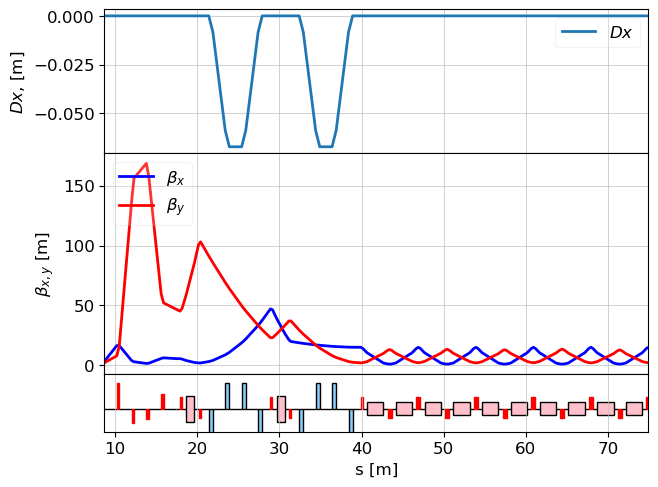This notebook was created by Sergey Tomin (sergey.tomin@desy.de) who was inspired by questions from E.R. June 2017.
Tutorial N7: Lattice Design, Matching, and Twiss Backtracking
Outline
- Design of a FODO lattice (undulator section) with specified maximum and minimum Twiss parameters
- Backtracking through chicanes
- Matching Twiss parameters in matching sections
Introduction
In this tutorial, we design a basic FEL beamline for an external seeding configuration. The layout consists of:
- Matching section
- Modulator – Chicane – Modulator – Chicane
- FODO lattice (undulator section)
The FODO section consists of repeating cells:
undulator – QF – undulator – QD – undulator – QF – ...
where QF and QD are focusing and defocusing quadrupoles, respectively.
We assume that:
- The maximum and minimum values of the beta functions in the undulator section are known
- The chicane geometry and parameters are predefined
- The Twiss parameters at the entrance of the matching section are given
While this problem can be solved in multiple (and possibly simpler) ways, we take a structured approach to demonstrate the use of Ocelot’s matching and backtracking tools:
- Match Twiss parameters within the FODO lattice to reach desired beta amplitudes using the
matchfunction - Perform Twiss backtracking through the chicanes and modulators using the
twissfunction - Use the
MagneticLatticeclass to construct the full lattice
Optics Design and Matching
Optics design is still something of an art — and only a few people in the world truly excel at it
(and the author of this notebook is certainly not one of them — at least not yet! :) ).
This tutorial is not aimed at producing an optimal design, but rather to illustrate the use of Ocelot’s matching functions in a practical setting.
# the output of plotting commands is displayed inline within
# frontends, directly below the code cell that produced it.
%matplotlib inline
from time import time
# this python library provides generic shallow (copy)
# and deep copy (deepcopy) operations
from copy import deepcopy
# import from Ocelot main modules and functions
from ocelot import *
# import from Ocelot graphical modules
from ocelot.gui.accelerator import *
initializing ocelot...
Step 1. FODO lattice matching
Design the simplest FODO lattice
# example of the FODO
U = Undulator(nperiods=50, lperiod=0.04, Kx=1)
D = Drift(l=0.5)
QF = Quadrupole(l=0.25, k1=1)
QD = Quadrupole(l=0.25, k1=-1)
M1 = Marker()
cell = (M1, QF, D, U, D, QD, QD, D, U, D, QF)
# suppose we have 5 cells or 10 undulators
fodo = cell*5
Periodic solution for FODO lattice
Note
- In the most cases to find twiss periodical solution we do not need to put the initial conditions and we can use following command to calculate twiss parameters: tws = twiss(lat)
BUT
- To take into account undulator vertical focusing effect we have to define the energy of the electron beam. and in that case we have to define initial condition like that:
# create MagneticLattice object
lat_fodo = MagneticLattice(fodo)
tws0 = Twiss()
# by default the all parameters are zero and
# that what we need to force the twiss function
# to calculate periodic solution
# print(tws0)
# And we need to define the beam energy
tws0.E = 1 # GeV
tws = twiss(lat_fodo, tws0=tws0)
plot_opt_func(lat_fodo, tws, legend=False)
plt.show()
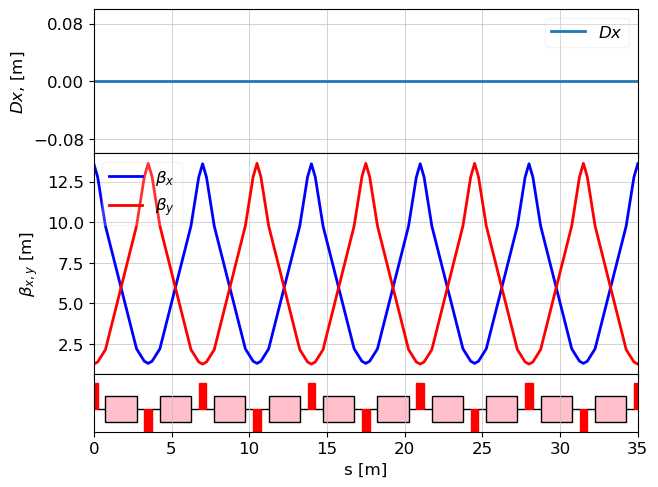
Matching
In Ocelot there is function match() to perform some standard matching procedures.
def match(lat, constr, vars, tw):
...
return res
where
-
lat: MagneticLattice -
constr: dictionary, constrains. Example:-
'periodic':True - means the "match" function tries to find periodic solution at the ends of lattice:
constr = {elem1:{'beta_x':15, 'beta_y':2}, 'periodic':True} -
"hard" constrains on the end of elements (elem1, elem2):
constr = {elem1:{'alpha_x':5, 'beta_y':5}, elem2:{'Dx':0 'Dyp':0, 'alpha_x':5, 'beta_y':5}} -
or mixture of "soft" and hard constrains:
constr = {elem1:{'alpha_x':[">", 5], 'beta_y':5}, elem2:{'Dx':0 'Dyp':0, 'alpha_x':5, 'beta_y':[">", 5]}} -
in case one needs global control on beta function, the constrains can be written following way.
constr = {elem1:{'alpha_x':5, 'beta_y':5}, 'global': {'beta_x': ['>', 10]}}
-
-
vars: list of elements which will be varied during optimization, e.g. vars = [QF, QD]can be
- Quadrupole (vary strength 'k1'),
- SBend, RBend, Bend (by default vary 'k1' but can be "angle"),
- Solenoid (vary strength "k"),
- Drift (vary length "l")
-
tw: Twiss(), initial Twiss
Optional arguments:
verbose: True, allow print output of minimization proceduremax_iter: 1000, number of iterationsmethod: string, available 'simplex', 'cg', 'bfgs'weights: function returns weights, for example-
vary_bend_angle: False, allow to vary "angle" of the dipoles instead of the focusing strength "k1"min_i5: False, minimization of the radiation integral I5. Can be useful for storage rings optimizations.returnresult
# constrains
constr = {M1:{'beta_x':15, 'beta_y':2}, 'periodic':True}
# variables
vars = [QF, QD]
# initial condition for twiss
tw0=tws[-1]
match(lat_fodo, constr, vars, tw0, verbose=False)
# results
print("QF.k1 = ", QF.k1)
print("QD.k1 = ", QD.k1)
tws0=Twiss()
tws0.E = 1 # GeV
tws = twiss(lat_fodo, tws0=tws0)
# let's variable *tws_fodo* will be the twiss
# parameters on the FODO entrance
tws_fodo = tws[-1]
plot_opt_func(lat_fodo, tws, legend=False)
plt.show()
initial value: x = [1, -1]
Optimization terminated successfully.
Current function value: 0.000017
Iterations: 42
Function evaluations: 82
QF.k1 = 1.071039959675296
QD.k1 = -0.8579474979724729
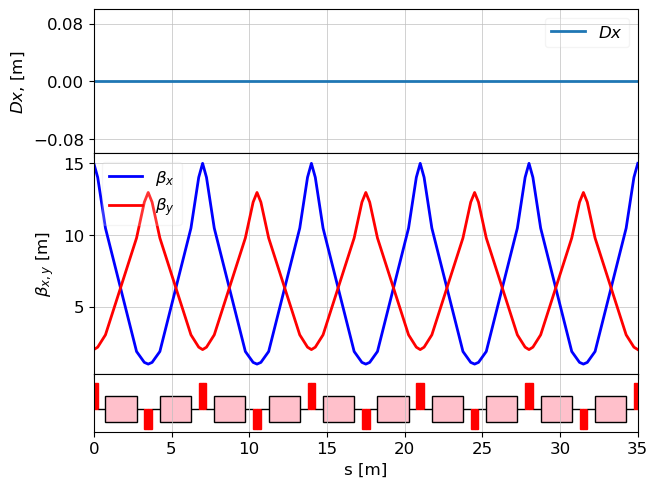
Step 2. Chicanes.
# undulator + chicane + undulator + chicane
modulator = Undulator(nperiods=10, lperiod=0.1, Kx = 2)
# Chicane from CSR example with small modifications
b1 = Bend(l = 0.5, angle=-0.0336, e1=0.0, e2=-0.0336, gap=0, tilt=0, eid='BB.393.B2')
b2 = Bend(l = 0.5, angle=0.0336, e1=0.0336, e2=0.0, gap=0, tilt=0, eid='BB.402.B2')
b3 = Bend(l = 0.5, angle=0.0336, e1=0.0, e2=0.0336, gap=0, tilt=0, eid='BB.404.B2')
b4 = Bend(l = 0.5, angle=-0.0336, e1=-0.0336, e2=0.0, gap=0, tilt=0, eid='BB.413.B2')
d = Drift(l=1.5/np.cos(b2.angle))
start_csr = Marker()
stop_csr = Marker()
# define chicane frome the bends and drifts
chicane = [start_csr, Drift(l=1), b1, d, b2,
Drift(l=1.5), b3, d, b4, Drift(l= 1.), stop_csr]
# For sake of buity add randomly couple of the quadrupoles
D1 = Drift(l=0.5)
echo = (D1, QF, D1, modulator, D1, QD, chicane, QF, D1, modulator,D1, QD, chicane)
Chicane parameters
For example, one wants to know R56 of the whole chicane. It can be easily calculated
lat_chic = MagneticLattice(chicane)
# in that case energy is not important we do not have
# energy dependant elements here
R = lattice_transfer_map(lat_chic, energy=0)
print("R56 = ", R[4,5]*1000, "mm")
R56 = -4.1443249349333655 mm
Backtracking though chicanes.
We know twiss parameters on the entrance of the FODO but for backtracking we need to
- invert alphas
- and invert the lattice (change the order of the element)
# inverting alphas
tws2 = Twiss()
tws2.alpha_x = -tws_fodo.alpha_x
tws2.alpha_y = -tws_fodo.alpha_y
tws2.beta_x = tws_fodo.beta_x
tws2.beta_y = tws_fodo.beta_y
# invert the lattice
echo_inv = echo[::-1]
lat_echo_inv = MagneticLattice(echo_inv)
# calculate twiss
tws_echo = twiss(lat_echo_inv, tws0=tws2)
tws_echo_inv_end = tws_echo[-1]
# show the twiss parameters of INVERTED echo
plot_opt_func(lat_echo_inv, tws_echo, legend=False)
plt.show()
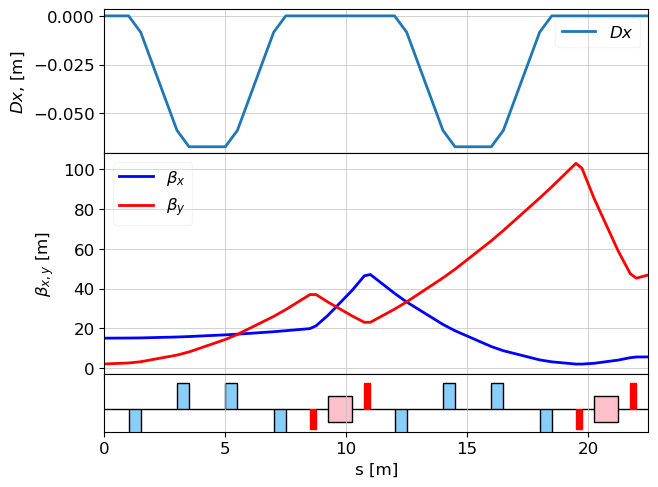
So twiss parameters on the entrance of the echo lattice are:
# inverting alphas again is needed
tws_e = Twiss()
tws_e.beta_x = tws_echo_inv_end.beta_x
tws_e.beta_y = tws_echo_inv_end.beta_y
tws_e.alpha_x = -tws_echo_inv_end.alpha_x
tws_e.alpha_y = -tws_echo_inv_end.alpha_y
lat_echo_fodo = MagneticLattice((echo, fodo) )
tws_all = twiss(lat_echo_fodo, tws_e)
plot_opt_func(lat_echo_fodo, tws_all, legend=False)
plt.show()
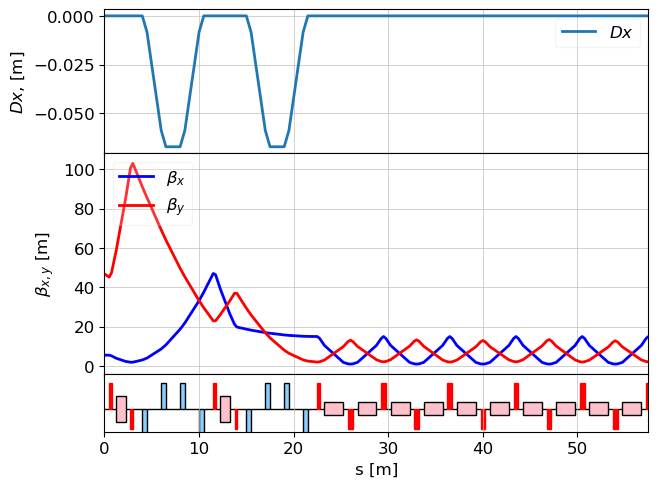
Step 3. Matching section
Q1 = Quadrupole(l=0.3, k1=1)
Q2 = Quadrupole(l=0.3, k1=1)
Q3 = Quadrupole(l=0.3, k1=1)
Q4 = Quadrupole(l=0.3, k1=1)
m1 = Marker()
m2 = Marker()
dm = Drift(l=1.5)
match_sec = (m1, dm, Q1, dm, Q2, dm, Q3, dm, Q4, dm, m2)
lat_m = MagneticLattice(match_sec[::-1])
Matching
As it was mentioned above, matching will not give you desired values if your geometry of initial conditions are poor. Because our goal is not a good design but showing the concept of OCELOT usage, we choose very relax condition. Twiss parameters on the entrance of the matching section:
- beta_x = 5
- beta_y = 5
- alpha_x = not defined
- alpha_y = not defined
the twiss parameters on the exit of matching section are defined by echo section
# constrains
constr = {m1:{'beta_x':5, 'beta_y':5},
m2:{'beta_x':tws_e.beta_x, 'beta_y':tws_e.beta_y,
'alpha_x': -tws_e.alpha_x, "alpha_y":-tws_e.alpha_y}}
# variables
vars = [Q1, Q2, Q3,Q4]
# initial condition for twiss
match(lat_m, constr, vars, tw0, verbose=False)
for i, q in enumerate(vars):
print("Q"+str(i+1)+".k1 = ", q.k1)
tws0 = Twiss()
tws0.beta_x = tws_e.beta_x
tws0.beta_y = tws_e.beta_y
tws0.alpha_x = -tws_e.alpha_x
tws0.alpha_y = -tws_e.alpha_y
tws = twiss(lat_m, tws0)
plot_opt_func(lat_m, tws, legend=False)
plt.show()
tws0 = tws[-1]
tws0.alpha_x = -tws[-1].alpha_x
tws0.alpha_y = -tws[-1].alpha_y
initial value: x = [1, 1, 1, 1]
Optimization terminated successfully.
Current function value: 214917575.120251
Iterations: 106
Function evaluations: 197
Q1.k1 = 2.355853351631101
Q2.k1 = -1.3155292135369026
Q3.k1 = -0.9164603176527466
Q4.k1 = 1.332649679467849
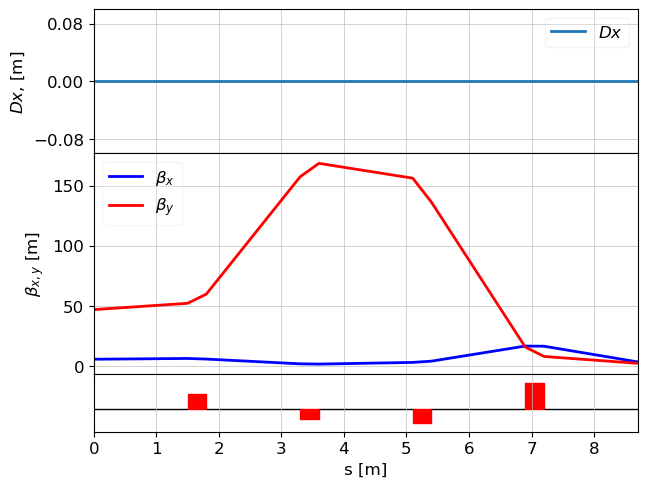
FINAL Lattice
cell = (match_sec, echo, fodo)
# fodo quadrupoles
lat = MagneticLattice(cell)
tws = twiss(lat, tws0)
plot_opt_func(lat, tws, legend=False)
plt.show()
